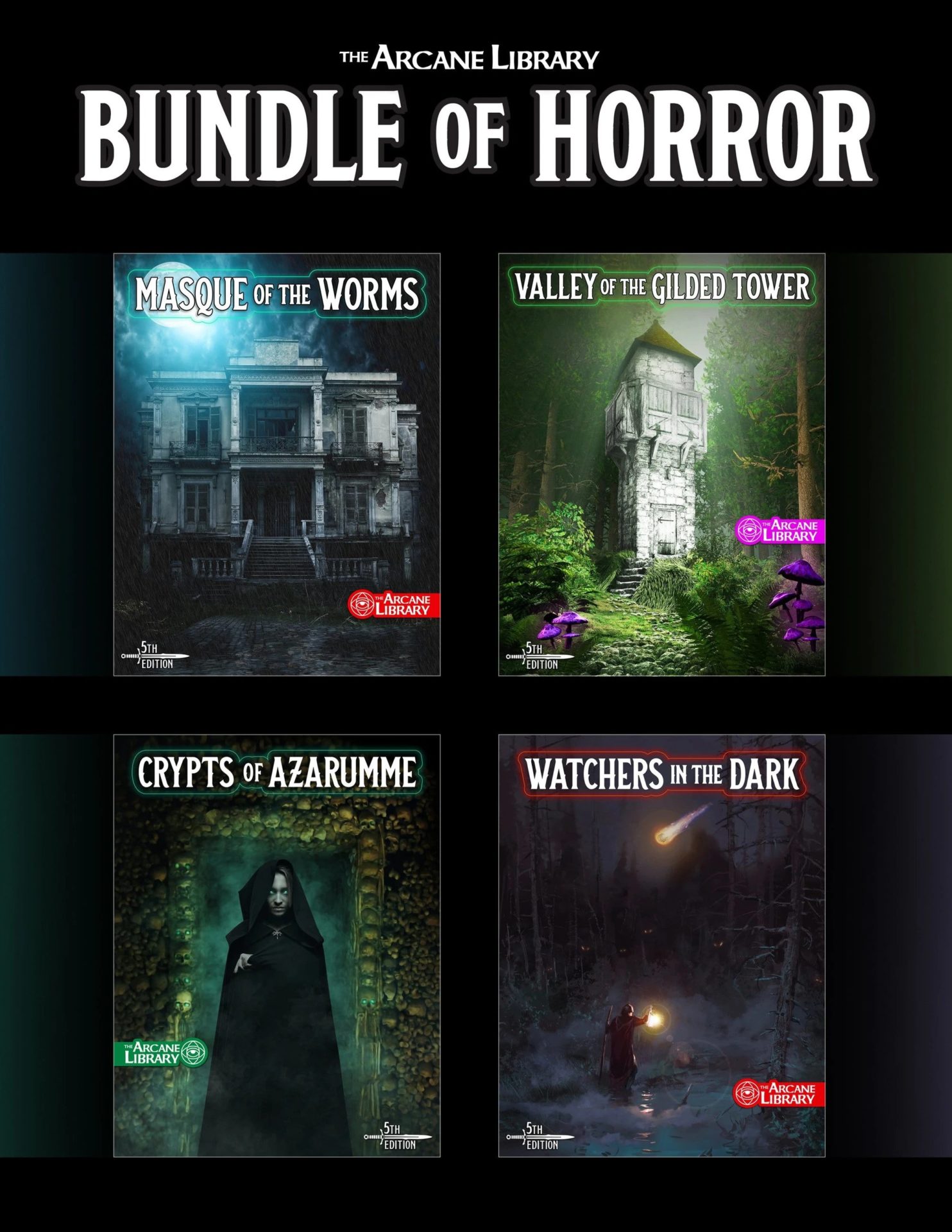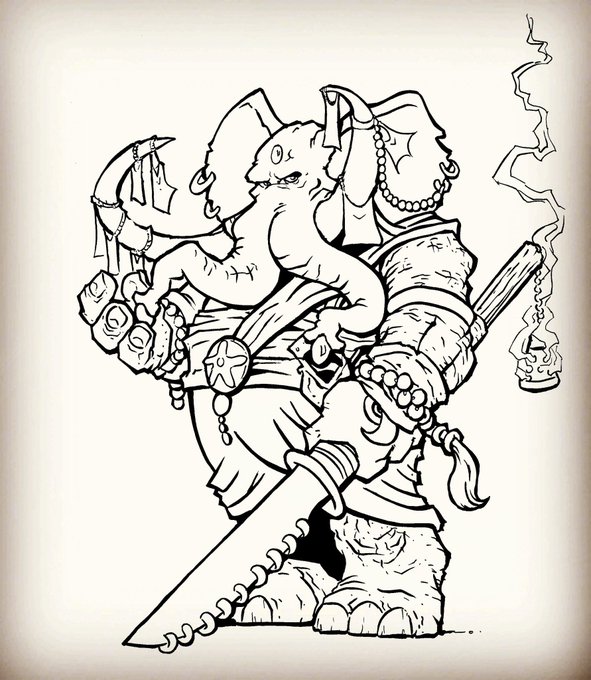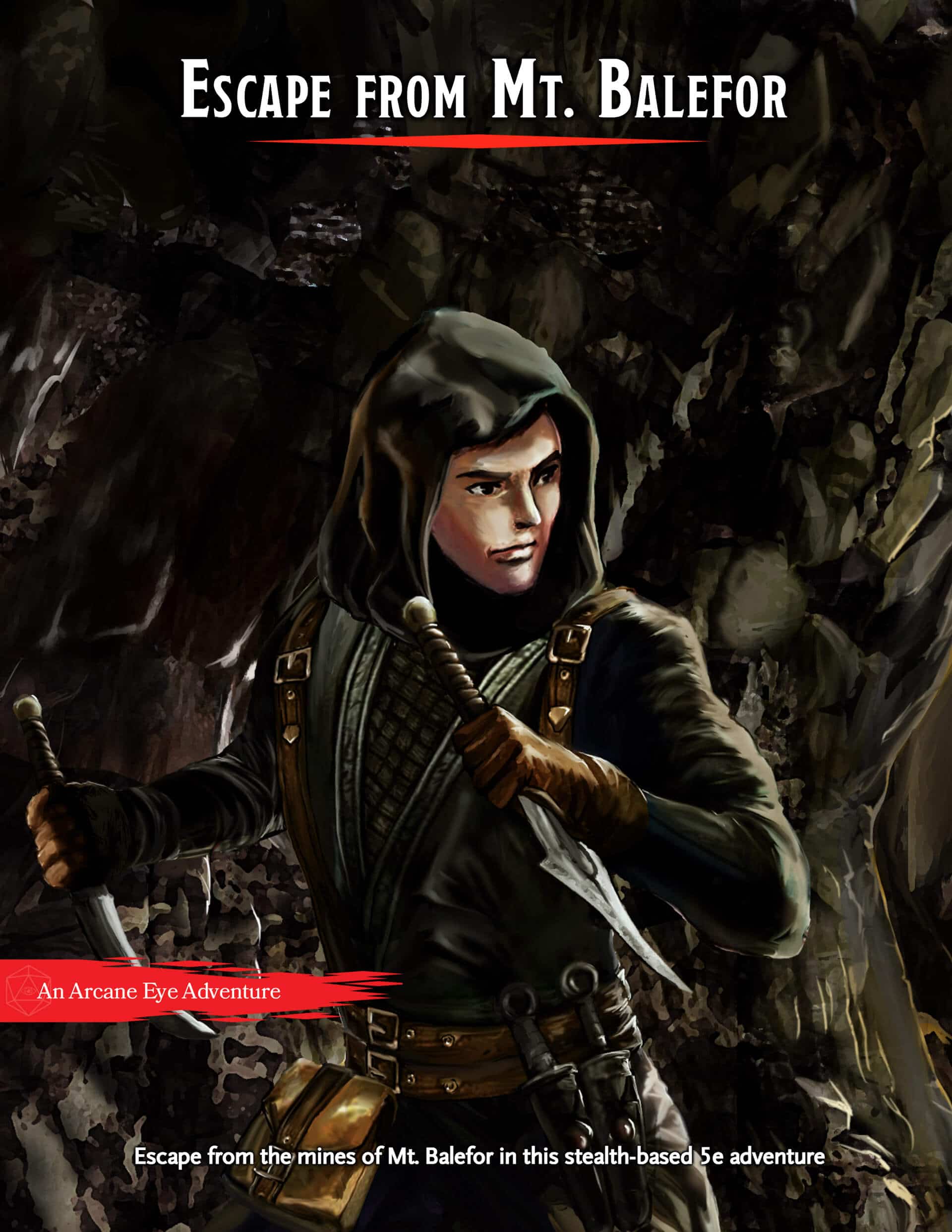The Arcane Library Interview
Published on August 21, 2020, Last modified on February 5th, 2021
We’re back with another fantastic interview! This time we’ve connected with Kelsey Dionne, founder of The Arcane Library.

Homepage - - The Arcane Library
Table of Contents
- About The Arcane Library
- The Interview
- Tell us about The Arcane Library. How did it start?
- Your adventures feature some amazing plot hooks, characters, and locations. What is your process for coming up with a new adventure and writing it?
- Is there anything that inspires your adventures outside the world of D&D?
- You have quite a few adventures that are horror-themed. What attracts you to this genre in particular for D&D adventures?
- Writing an adventure is certainly different than writing a novel in that far more information needs to be conveyed to the reader in a short amount of time. What do you think makes a good D&D adventure?
- Your adventures are structured in a way that keeps them concise and has a style that is uniquely your own. How did you come up with this presentation style and what advantages do you think it holds over more traditional publications?
- Do you have a favorite monster or magic item that you’ve created?
- What is your favorite level tier to write adventures for? What is your least favorite? (Low – 1-7, Medium – 8-14, High – 15-20)? Why?
- How and with whom do you typically playtest your adventures? Do you often find you need to rework the balance of certain encounters?
- What does the future have in store for The Arcane Library? Could you give us some insight into what you have planned?
- Closing
About The Arcane Library
Since 2017, Kelsey has been consistently putting out best-selling Dungeons & Dragons 5e adventures featuring stunning full-color artwork, battle maps, combat cards, as well as homebrewed monsters and items. Some of her most popular work includes:
- The Secrets of Skyhorn Lighthouse – Downloaded over 90,000 times with 250+ 5-star reviews on DM’s Guild
- The Corruption of Skyhorn Lighthouse – The Secrets of Skyhorn Lighthouse sequel hit #1 most popular adventure on DM’s Guild
- The Monstrous Lexicon – Kelsey co-wrote The Monstrous Lexicon which features a huge collection of original monsters as well as four new playable races for D&D 5e
The adventures are structured in a way to make them concise, yet still easy to follow, putting the power back into the hands of the DM.
These days, we’ve found that many adventures are overwritten and are bogged down by the details. In contrast, The Arcane Library’s adventures require less preparation and more room for DM interpretation, making each session feel truly unique.
Each page corresponds with a single encounter, including dramatic questions that should be answered by gameplay before moving on, as well as how to transition to the next encounter. Needless to say, The Arcane Library hosts some of our favorite adventures to date.
To get a taste of what The Arcane Library is all about, you can join the newsletter for a free adventure! Kelsey regularly sends out updates, articles, and exclusive D&D material to her subscribers, so don’t miss out.

The Interview
Tell us about The Arcane Library. How did it start?
The Arcane Library started off as an outlet for me to try adventure writing and see if I could put my own spin on D&D material. I didn’t really know what I was getting myself into when I first started — I would never have believed the library would keep growing until it turned into a full-time undertaking. At first, it was just me writing adventures in my off-hours and on weekends!
Your adventures feature some amazing plot hooks, characters, and locations. What is your process for coming up with a new adventure and writing it?
Thank you so much! Coming up with new adventures is often a mix of daydreaming and absorbing material I think is cool. Eventually, a lot of small influences and ideas subconsciously stir together into a larger, unique idea. Once I have a kernel of that sort (for example, a mysterious lighthouse invaded by an evil force), I start to poke and prod at what elements will turn it into a concrete problem with interesting steps toward a solution for the characters to take.
Is there anything that inspires your adventures outside the world of D&D?
Absolutely! I get most of my inspiration from watching movies and shows, reading fiction and nonfiction, playing video games, and enjoying other creators’ art. For example, one time I got the idea for an adventure I wrote by reading an article about the security team that guards a political leader. Inspiration hides in a lot of strange places!
You have quite a few adventures that are horror-themed. What attracts you to this genre in particular for D&D adventures?
Horror is really fun to write because it calls for a lot of foreshadowing and suspense. I love setting things up so the characters go through the story discovering revelations and secrets that form the whole truth. It’s satisfying to write material with that structure. But when it comes to watching horror movies or playing in horror games myself, I’m actually a big scaredy-cat!

Writing an adventure is certainly different than writing a novel in that far more information needs to be conveyed to the reader in a short amount of time. What do you think makes a good D&D adventure?
I think a good D&D adventure needs to trust the Dungeon Master. As writers, we sometimes want to give every single line, angle, and possibility to the person running the game, but that’s actually counterproductive because it becomes too much material to process. So putting only as much information as necessary into as little space as possible is, to me, the best sort of adventure writing.
Your adventures are structured in a way that keeps them concise and has a style that is uniquely your own. How did you come up with this presentation style and what advantages do you think it holds over more traditional publications?
The style I use in my adventure writing is an outgrowth of the way I took notes for my own games! I’m more of a “big picture” DM who goes into a session with a few bullet points about the plot, NPCs, and events. From there, I rely on the ebb and flow at the table to move the story along and keep the pacing exciting. So I try to write my adventures in a way that keeps things flexible, is easy-to-reference, and trusts the DM to make rulings and changes in the moment. A benefit my style might provide over traditional material is that, hopefully, it’s easy for the DM to keep the game moving at a natural pace. I want DMs to be able to get out of the writing and into the story just as much as the players.
Do you have a favorite monster or magic item that you’ve created?
One of my favorite monsters to develop appears in The Monstrous Lexicon, a book I wrote with Matt Rauscher (The Pickled Dragon). It’s a culture of elephant-men mystics called the Grooleshi, and they were a ton of fun to develop. They’re monsters and a playable character race with a cool connection to precious gemstones. I want to be a Grooleshi monk in a campaign some day!

What is your favorite level tier to write adventures for? What is your least favorite? (Low – 1-7, Medium – 8-14, High – 15-20)? Why?
I prefer writing for low tiers simply because the characters are still a bit fragile, so the sense of danger and excitement is very real. Writing high-tier dungeons can be intimidating, so that’s probably my least favorite tier, although they’re fun to take on as a personal challenge. It’s easy to worry that at higher levels, the characters will have some obscure spell or ability that completely derails the adventure. It can feel like a lot to juggle. I’ve found it helps when writing for higher tiers to keep a list of spells to be aware of (not to nerf, necessarily, but to bear in mind). That helps you avoid writing three encounters in a row that can all be defeated by teleport. That said, it’s great to write one encounter that teleport easily defeats so the players feel awesome overcoming a challenge with their high-powered spells!
How and with whom do you typically playtest your adventures? Do you often find you need to rework the balance of certain encounters?
I usually playtest my material in a totally sneaky way on my D&D groups. I don’t tell them it’s an encounter for publication, and I do it in small doses on the things I feel need a good test run. I tend to get a lot more honest reactions from my players when they don’t realize something is a playtest. Odd as it sounds, I more often rework NPCs, pacing, and story elements rather than combat as a result of a playtesting. Combat can be difficult to balance since there isn’t consistency with each group’s party composition and optimization level, so I usually let those stand without much fiddling. But motivation, pacing, and hooks have to hit well across the board. If those elements don’t land with the right impact, I’ll tweak or totally re-write them.
What does the future have in store for The Arcane Library? Could you give us some insight into what you have planned?
Absolutely! Right now, I’m working on a set of adventure anthologies called Legends of the Library. I am (perhaps too ambitiously) planning five volumes that, when combined, will have an adventure for each level going from 1 – 20. The adventures aren’t going to be explicitly connected by story, but some will have links to each other in ways I hope are fun to discover. I’m about a month out from having the first volume done if all goes according to my evil plan.
Closing
Thank you so much to Kelsey for stopping by and chatting about D&D adventures with us, we can’t wait to see where you go from here! As always, please consider supporting content creators if you love D&D. The easiest way to support Kelsey is by joining The Arcane Library’s newsletter, or by purchasing her adventures and other products on DM’s Guild and The Arcane Library shop.
You can follow The Arcane Library on Twitter, Instagram, Facebook, DMs Guild.
If you have any questions or would like to see more interviews and news about upcoming products in the world of D&D, please post a comment below. If you like our content, subscribe to Arcane Eye!
